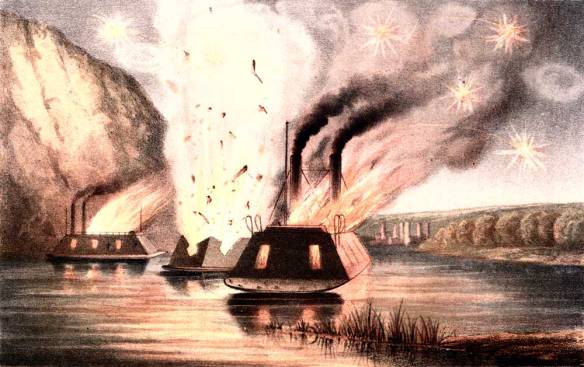“The Blowing up of the James River Fleet, on the night of the Evacuation of Richmond.” Painting by Allen C. Redwood showing the sinking of CSS Virginia II, CSS Fredericksburg and CSS Richmond on April 3, 1865 during the American Civil War.
Small Confederate naval squadron on the James River, from just east of Richmond to the Chesapeake Bay. Within days of Virginia’s secession from the Union on April 17, 1861, the James River Squadron was formed as part of the Virginia State Navy. Subsequently, upon Virginia joining the Confederate States of America on June 8, 1861, the following ships were turned over to the Confederacy: the sailing ship Confederate States (ex–USS United States); the side-wheeler steam gunboats Jamestown and Patrick Henry; and the other steam vessels George Page, Logan, Northampton, and Teaser. Commander John R. Tucker assumed command of the squadron.
Following its commissioning in early March 1862, the Confederate ironclad Virginia, formerly the U.S. Navy steam frigate Merrimack, became the squadron’s flagship. During the Battle of Hampton Roads, on March 8–9, it engaged and destroyed the Union sailing sloop Cumberland and the sailing frigate Congress and fought to a draw the U.S. Navy ironclad Monitor. The squadron’s second flagship, the Patrick Henry, was modified for use as a schoolship. In October 1863 it became the home of the Confederate States Naval Academy at Drewry’s Bluff, under the command of First Lieutenant William H. Parker.
Other ironclads subsequently joined the squadron. By 1864 it included three ironclads in the upper James: the Richmond, Fredericksburg, and Virginia II. The Confederates also deployed in the river an elaborate system of electrically detonated mines, known as torpedoes.
In January 1865 Flag Officer John K. Mitchell, Confederate commander of the James River Squadron, under pressure from Secretary of the Navy Stephen R. Mallory to take action, launched a precipitous assault down the James River in an effort to take the Union Army’s supply base at City Point. Mitchell commanded 11 ships, including the 3 most powerful remaining Confederate ironclads: the Richmond, Fredericksburg, and Virginia II. The engagement of January 23–24 ended in failure. The gunboat Drewry blew up from a Union mortar shell, while the torpedo boat Scorpion was captured. The Richmond and Virginia II were both damaged. Displeasure with Mitchell’s handling of the affair led to his replacement on February 18 with Rear Admiral Raphael Semmes.
On April 2, when Confederate general Robert E. Lee abandoned Richmond and Petersburg and attempted to escape westward, Semmes had no choice but to scuttle his ships. Early on the morning of April 3, Semmes ordered the three ironclads fired and the five wooden gunboats moved upstream to Richmond.
At Richmond, the men of the squadron found much of the city in flames, including the schoolship Patrick Henry. After their crews came ashore, the gunboats were then themselves set on fire and set adrift in the James. The gunboat Beaufort failed to sink, and Union forces took possession of it and the unfinished ironclad Texas.
A number of sailors from the squadron formed Tucker’s Battalion and fought in the Battle of Sayler’s Creek on April 6, 1865. They subsequently surrendered with the rest of the Army of Northern Virginia at Appomattox Court House three days later.
References Coski, John M. Capital Navy: The Men, Ships and Operations of the James River Squadron. Campbell, CA: Savas, 1996. Still, William N., Jr. Iron Afloat: The Story of the Confederate Armorclads. Columbia: University of South Carolina Press, 1985.
